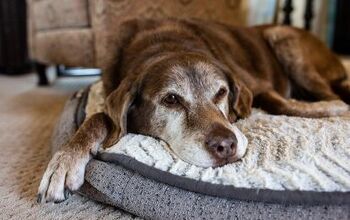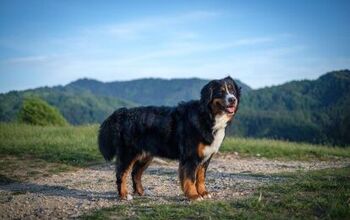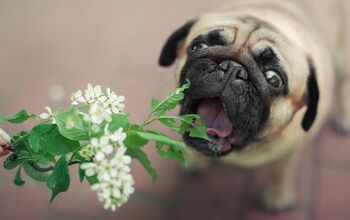Pups With Tents: Hot Dogs And Campfire Safety

A day spent trekking in the outdoors isn’t complete without a campfire. And unless you’re roasting wieners, campfires and dogs shouldn’t mix! Kevin Roberts offers his fire safety tips when you’re camping with your dogs.
There is something about the great outdoors that really makes me hungry. Perhaps it’s all that fresh air, or memories of sticky s’mores enjoyed during childhood. Whatever it is, my favorite meals are the ones cooked over the campfire. Because I always camp with my dogs, mealtime presents some challenges. There’s food, open fire, and dogs – and this is not a combination that you want to lose control of.
Related: Rustic Tips To Remember When Camping With Dogs
I’ve been around the campfire for many years, and as such, have a few things to consider when cooking on a fire with your dogs around:
- The fire pit itself, whether made of metal or rocks, will hold heat for a long time after the fire has burned down. Keep your dogs away from the fire pit, even when there’s no fire lighted. Before you even light the fire, teach your dog to stay away. When we arrive at a site, if the dogs show any interest in the fire pit, I correct them, and give them a place to settle and stay, well away from the pit.
- Sticks – a temptation that’s too great for some dogs to leave alone. This can be a bit of a problem if you are collecting wood for a fire. A neatly stacked pile of firewood and kindling is a great way to avoid tripping over a stray branch, but for some dogs, a pile of sticks is just too tempting! Train your dog to leave the firewood pile alone.
- Put your axe away. It’s the lazy camper who, when finished with the axe, leaves it in a stump. A stump is at eye level for many dogs, so put your axe away as soon as you are done to avoid any mishaps.
Related: Dog-Friendly Adventures in Florida
- Once the fire is burning, make sure your dog is far enough away from the flames and is sitting upwind, so wayward sparks and smoke won’t bother him. I once saw a family whose dog had been tethered near a fire, and a wayward spark landed on the leash, which slowly belted and burned! The dog was fine, but the leash ended up being a lot shorter.
- Even if it’s not your fire pit and you’re camping in the area, be sure to keep your dog out of it. Lazy campers often throw glass, tinfoil, or bones into the fire pit. Parts of these are burned and they hide with the ash and debris left behind. Burned bones and bits of charred food are too tempting for many dogs but aren’t safe.
- When I have a campfire with my dogs, I never share food with them. Simply, I don’t want to create the expectation that any of the food or utensils are for sharing. At home, I will happily drop them a piece of chicken, or toss some kale in their food. But around a campfire, where things aren’t as controlled, I simply don’t want them even thinking that they can have any of the food.
- Avoid throwing any food scraps or trash in the fire when your dog is around. While this may seem like a great way to dispose of your waste, the scents that they create can create an irresistible temptation for your dog.
It doesn’t matter how hard you try to avoid it, spending time around a campfire is going to involve some exposure to smoke. If you’re hanging out with your dog by the fire, make sure that you are familiar with the warning signs of smoke inhalation. Senior dogs, puppies, and brachycephalic dogs (those with short snouts like pugs and Boston terriers) are more likely to experience problems due to smoke.
Pay careful attention for any of the following:
- Coughing
- Wheezing or loud breathing
- Trouble breathing
- Disorientation
- Fatigue
- Reduced thirst or appetite
- Red eyes, blinking, pawing at their eyes, or excessive tearing up
If you notice any of these signs, contact your veterinarian. Share your concerns and they will guide you on the next best steps in terms of your dog’s care.
Camping with my doggos is one of my favorite things and once I’m sure we’re cool with fire safety, I pay attention to some other important camping with dog tips too. Here are a few:
- Make sure your dogs are WELL-identified. If they don’t have microchips, we recommend they do and make sure their ID tags are clean, easy to read, and UPDATED. Too often someone will find a lost dog with outdated info and it’s hard for the finder and your dog to have any peace about it. Not to mention you. Make sure your dog’s tag has your name, a CURRENT phone number (one that you can text is even easier), and the DOG’S NAME so they’ll be able to comfort your dog while you’re being looked for. If you are camping at an established campground, you may also wish to add a temporary tag on your dog’s collar with your campsite number. But don’t forget to update this if you are moving to a new location!
- First Aid Kits. Sure, you have one for you, but do you have one for your dog? What does a dog first aid kit even look like? Not too different from yours, really. You can buy them online if you like or you can make your own. Either way, make sure your dog’s first aid kit has any medicines or vitamins he takes currently, some Benadryl and probiotics for allergies and upset tummies, some antiseptic, and OH YES–pest repellant. The last thing you want is for your pup to come home with fleas or ticks or worse–bites that lead to things like Lyme’s Disease.
- Hydration. More and more of it, please. It’s so important to keep your dog hydrated when camping. Be sure you’ve got plenty of water for you and your dog and offer it to him regularly. He may not drink because he’s excited to be with YOU! One way to keep your dog hydrated when he isn’t all that interested in stopping to drink is to add water to his food. Not only does that ensure that your dog is drinking water, but it will also create a tasty gravy making it seem like a special treat.
- Booties. He may laugh (in his doggy way) at the thought of booties, but they can protect his paws from the things the outdoors may throw–particularly FIRE sparks or hot ground or insects and snakes even. You wear special shoes for camping and hiking, right? So should he.
- Crate. Your pup may be way out of the crate stage but…a crate while camping to help keep him safe is a great idea and one you’ll be sorrier you didn’t have when you needed it than if not. You can add a comfortable bed and some of your favorite toys to your dog’s crate to make it a more positive space. Another way to keep your dog happy while spending time in the crate is to provide him with his favorite chew.
- Cooling Products. If you’re spending your time outdoors during the hot, summer months, you may want to consider cooling products to keep your dog from getting overheated. There are many different options on the market depending on your dog’s preferences. This includes cooling mats, vests, bandanas, and collars. Cooling mats are often activated by weight, meaning that laying on his bed will be all that it takes to cool off. On the other hand, cooling clothing and accessories are usually activated by getting them wet before putting them on. As the water evaporates, it cools off your pup.
- Vet records. Ideally part of the first aid kit, but a good idea to scan in on your phone too because then you won’t have to worry about scrambling if there’s something like an ER visit for a snake bite. Trust us, it can happen, and the vet records will help!
- Other Important Documentation. In addition to your vet records, you should also make sure that you have all the information necessary if your dog were to go missing. Even the best-behaved dog could end up in a situation where they are wandering or tracking a scent and get turned around. This includes information about any identifying features as well as a photograph of your dog. Make sure that it is an actual photograph, don’t just rely on the pictures on your phone. Having a physical photograph will give you something that can easily be shared with others, as needed.

Kevin Roberts lives for adventure. Together with his pack of rescue dogs and his husband, he spends as much time outdoors as possible. Kevin lives by the motto: "Get outside and play with your dogs!
More by Kevin Roberts























